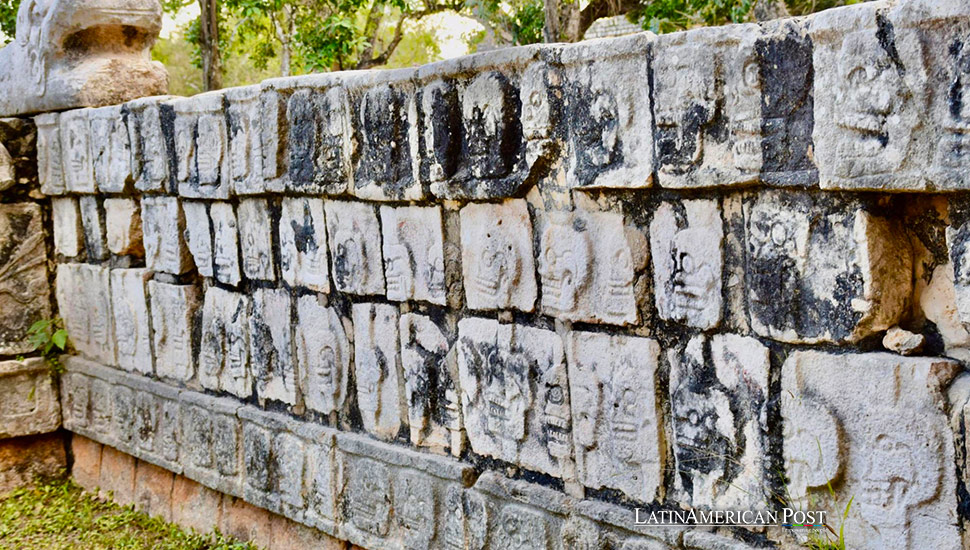Ancient DNA Study Sheds Light on Maya Sacrifices in Mexico’s Chichén Itzá

An ancient DNA analysis of 64 child sacrifice victims in Chichén Itzá reveals they were all boys, including pairs of twins, reflecting deep cultural and mythological significance. The study also explores the genetic impact of colonial-era epidemics on indigenous populations.
Chichén Itzá, located in Mexico’s Yucatán Peninsula, was one of the most significant cities of the Maya civilization. Today, it is one of Mesoamerica’s most studied archaeological sites, mainly due to the human sacrifices performed there for centuries. Despite their importance in Maya culture, these rituals remain somewhat mysterious. However, recent advancements in ancient DNA analysis have shed new light on these practices, revealing fascinating details about the sacrificial victims and their broader genetic legacy.
A recent study published in the journal Nature involved analyzing ancient DNA from the remains of 64 individuals sacrificed in Chichén Itzá between 600 and 1100 AD. The findings were remarkable: all the victims were young boys, and among them were two pairs of twins. This discovery challenges previous assumptions about the Nature and selection of sacrificial victims in Maya culture.
The research was a collaborative effort involving scientists from the Max Planck Institutes for Evolutionary Anthropology and Geoanthropology in Germany, Mexico’s National School of Anthropology and History, the National Institute of Anthropology and History of Mexico, and the universities of Yucatán and Harvard. The study not only provides insight into the demographics of the sacrificial victims but also explores the genetic impact of epidemics on indigenous populations.
The analysis revealed that the boys, aged between 3 and 6, were likely selected from the same or closely related communities. Many were first- or second-degree relatives with similar diets, suggesting they were raised in the same environment before being chosen for sacrifice. This indicates a highly selective process rooted in cultural and possibly mythological significance.
Cultural and Mythological Significance
Chichén Itzá, a UNESCO World Heritage site, is renowned for its architectural marvels, such as the Temple of Kukulcán (El Castillo) and numerous ball courts where the Maya practiced a ritualistic sport. The Sacred Cenote, a natural sinkhole, was considered a gateway to the underworld by the Maya. It is here that the remains of hundreds of sacrificial victims, primarily young women and children, were discovered.
In 1967, an underground water chamber, or chultún, near the cenote revealed the remains of over a hundred young boys sacrificed between 600 and 1100 AD. The recent DNA analysis showed that these boys were likely sacrificed as a homage to the Hero Twins of Maya mythology, as suggested by the presence of identical twins among the victims.
Rodrigo Barquera, a researcher at Max Planck and co-author of the study, explained that discovering twins among the sacrificial victims provided a new perspective. “This was not just an offering; it was a particular homage to the Hero Twins of Maya mythology,” Barquera stated. The Hero Twins, prominent figures in the sacred book Popol Vuh, were sacrificed by the gods after losing a ballgame, symbolizing duality and rebirth.
The analysis also suggested that the sacrificial process for these children differed from that of other victims, as their bones did not show signs of typical sacrificial methods like heart extraction or decapitation. This distinction highlights the ritual’s unique Nature, potentially linked to the mythological significance of the twins.
Genetic Impact of Epidemics
The study also delved into the genetic consequences of colonial-era epidemics on indigenous populations. The Spanish conquest and the subsequent introduction of European diseases had a devastating impact on the native peoples of the Americas. The research compared the genomes of individuals from Chichén Itzá with those of the contemporary Maya community in Tixcacaltuyub.
The analysis revealed a significant genetic continuity in the region, indicating that many genetic traits have persisted despite the dramatic population declines due to wars, famines, and epidemics in the 16th century. One particularly notable finding was the presence of genetic adaptations related to diet, lifestyle, and resistance to infectious diseases, specifically Salmonella enterica.
Salmonella enterica was not present in the Americas before the arrival of Europeans. The genetic adaptations observed suggest that the Indigenous populations resisted this pathogen, which caused severe epidemics, such as the Cocoliztli outbreak of 1545. This adaptation has remained in the genetic makeup of the local populations to this day.
The findings from Chichén Itzá contribute to a broader understanding of pre-Columbian cultures in Latin America. The Maya civilization, known for its advanced mathematics, astronomy, and architectural knowledge, also practiced complex religious rituals, including human sacrifices. These practices, while often viewed through a lens of horror today, were integral to their belief systems and societal structures.
The genetic studies also highlight the resilience of indigenous populations in Latin America. Despite centuries of colonization, exploitation, and disease, these communities have preserved significant aspects of their genetic heritage. This resilience is a testament to the enduring strength and adaptability of the region’s indigenous peoples.
Furthermore, the collaboration between international and local institutions in this research underscores the importance of global partnerships in uncovering and preserving Latin America’s rich history. Such studies enhance our understanding of ancient civilizations and promote the recognition and respect of indigenous cultures today.
A New Understanding of Maya Sacrifices
The ancient DNA analysis of sacrificial victims at Chichén Itzá has provided unprecedented insights into the cultural and genetic history of the Maya civilization. The discovery that the victims were young boys, including identical twins, offers new perspectives on the ceremonial and mythological significance of these sacrifices. Additionally, the study’s exploration of genetic adaptations highlights the long-term impacts of colonial-era epidemics on indigenous populations.
Also read: Mexico’s Vaquita Marina Population Sees Low Numbers with Only Nine Sightings
As researchers continue to uncover the secrets of Chichén Itzá, these findings not only enrich our knowledge of Maya culture but also underscore the resilience and enduring legacy of Latin America’s indigenous peoples. The collaborative efforts of scientists from various countries and disciplines demonstrate the power of interdisciplinary research in unveiling the complexities of ancient civilizations and their lasting influence on contemporary societies.




